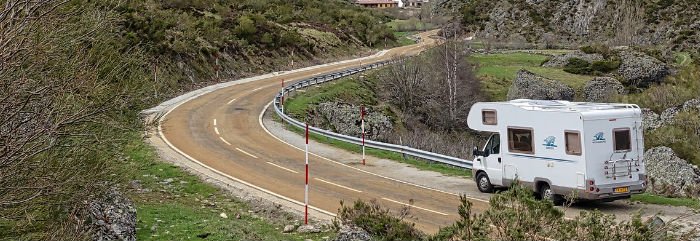Tyre care for motorhomes and caravans

The dangers
A tyre blow-out can be a catastrophic event, especially if you are travelling at speed with your caravan trailing behind you. Any tyre failure in these circumstances can lead to instability and imbalance – the safety and financial implications of this do not bear thinking about.
Delamination
This is where the thread detaches from the casing of the tyre, which can result in a tyre with a flailing thread devouring the side of your bodywork. This can lead to huge repair bills, or worse still, a serious accident.
Why would delamination occur? Well, this can be due to age, standing and poor pressure maintenance.
Here, we will look at the precautions you can take to reduce the chances of a disaster:
- Use the correct tyres for your motorhome or caravan: At purchase prices around 15% cheaper than dedicated motorhome tyres, van tyres (LCV) have their appeal. However, while legal to use on a motorhome, they are not designed for this use. LCV tyres generally go through periods of load and unload, whereas motorhomes can be consistently laden.
Motorhome tyres also have thicker walls and are designed for heavy loads, so can often operate at higher pressures. Overall, dedicated motorhome tyres offer better value for money, last longer, and provide a superior driving experience.
- Check your caravan tyres regularly: You should periodically check for any cuts or cracks to the surface and any lumps which indicate the surface has weakened, to the extent that air is pushing the inside out. Any weakening of the tyre walls is particularly dangerous. Remove any stones that may be lodged in the tread.
- Replace ageing tyres: With caravan and motorhome tyres, it’s wise to consider renewal when they are somewhere between five and seven years old – even when there may be plenty of tread left on them. Ultra-violet radiation and atmospheric ozone have an ageing effect on tyres, which can make a sudden failure more of a possibility.
Where do you find the age of the tyres? This is is marked on one of the side walls. If you are lucky, it will be facing you, but could also be on the inside wall of the tyre. It will show the week and year in numbers, e.g. (08 07) would signify the tyre was manufactured in the 8th week of 2007.
- There are specific tyre pressures for caravans and motorhomes: Check tyre pressures before every journey (when the tyres are cold) using an accurate and reliable gauge such as the ones found in a petrol station. Tyre pressures are measured in pounds per square inch (PSI).
Tyres for motorhomes and caravans require higher tyre pressures than cars, due to their weight. This is especially true of motorhomes, which can sometimes be over 3,000kg. Don’t make the mistake of assuming your caravan or motorhome requires the same tyre pressure as your car.
Adjust pressure in line with the vehicle manufacturers’ recommendations, considering any additional load. Usually the correct pressures can be found in the vehicle handbook, the plate on the driver’s door sill, or the fuel filler cap.
If you can’t obtain any information regarding the correct tyre pressures, contact your vehicle manufacturer.
- Tread: Check tread depth! The current legal requirement across the UK and Europe is 1.6mm across the central three quarters of the tyre. It is advisable if you are going away for a long trip to ensure you are over 3mm.
As well as the safety implications of travelling on an insufficient tread, the fine for each tyre is £2,500, and three points on your licence.
- Overloading: Ensure that you are operating within the tyre’s maximum operating weight, as an overloaded tyre will overheat and will increase the risk of a blowout.
Again, stressing the importance of using the correct tyres: a tyre with a lower load index than the caravan or motorhome manufacturer’s specifications can easily become overloaded.
- Tyre degradation due to standing: Avoid leaving a vehicle unused for many months between holidays, as this can cause flat spots or side-wall deformities, which can cause failures when back in use.
- Don’t take chances: Your family’s safety is your first priority, so take the time to ensure your motorhome or caravan tyres are in tip-top condition before leaving for that well-earned break. The best break is one where you remember the high spots of your time away, not the trials and tribulations encountered as a result of your equipment’s failure.
Sources
https://www.tyresafe.org/wp-content/uploads/2015/12/caravan-leaflet.pdf (PDF 1.7MB)
https://www.davan.co.uk/phantom-tyre-protector/
http://www.tyron.co.uk/about-tyron/

